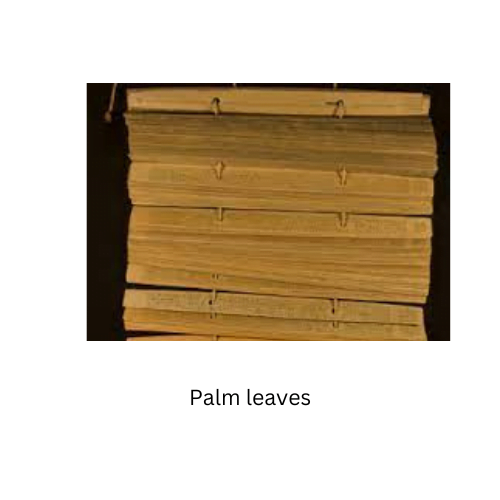In ancient times, images were the means of communication and expression of thoughts. 10,000 BC, the first drawings were found in a cave in southern France. Then 4 thousand years before ChrisTimest, the practice of writing on stones began. With the advent of human civilization, people started inventing various writing materials. Among these writing systems in vogue were papyrus, vellum, parchment, palm leaves, clay tablets etc.

Written Materials in Ancient Times
Thousands of years ago, human beings began to communicate their thoughts and ideas through written materials, which are discussed below:
- Papyrus: Papyrus was the primary writing material in ancient Egypt until 3000 BC. It comes from a type of papyrus tree that once grew abundantly along the Nile River in Egypt. The papyrus looks as thick as a human hand. The bark of papyrus is very thin and smooth. Therefore, if the bark were put together and covered with glue, it would be thick and hard like paper. After being pressed with a heavy object, the material was dried and transformed into paper. It was then written on using red ink and rolled up. A 120-foot-long roll of papyrus is currently preserved in the British Museum.

- Clay tablet: Ancient civilizations in what is now Iraq used clay tablets to record their thoughts in writing. This clay was made into different shapes and written on it, then dried in the sun or burned to preserve the hard clay. This writing method is called tablets. King Ashur of Syria had a library in Asurbanipal. This library was called Clay Tablet Library. Even that library catalog was made of clay tablets.

- Parchment: Parchment was invented during the 6th century in Asia Minor, which is present-day Turkey, to meet the demand for writing as the publishing industry flourished under the ancient kings of the UCC period. The hides of cows, sheep, and pigs were combined with clay and lime, and then smoothed out with iron and stone. Parchment was found to be more durable and long-lasting than papyrus. Today, there is a book made of parchment housed at the Asiatic Society of Calcutta.

- Velum: Velum leather is used as a writing material as it is very smooth and refined. Vellum was not made from all kinds of skins, only vellum was made from the skins of newborn cows and sheep. Vellum is an expensive writing material. Vellum was used only for very important, selected works of writing.

- Codex: In ancient times, the codex was a material made of wood. Codex’s were made by splitting the wood and then coating it with wax. Codex originated in China. Usually, the Chinese made the codex.

- Bhurjapatra: Bhurjapatra was the only writing material in the ancient subcontinent. Bhurjapatra was a type of tree bark. This bark is very smooth and the color looks like cinnamon and then it is written with ink. The scientific name of Bhurjapatra is “Paperifera.”

- Palm leaves: The Egyptians first used palm leaves as a writing material and it was later adopted in the ancient subcontinent. Even though the palm leaves are cut evenly and arranged in the shape of a manuscript, the work of writing continues.

- Teret leaves: Teret leaves are like palm leaves. But teret leaves are broad and long-lasting.

- Silk cloth: Cloth is made from silk. And writing materials are found on these cloths. The cloth used as writing material is called jute, potika or kosmicpot.

- Cotton paper: Cotton paper has a rich history that dates back to ancient China. It was first made from cotton rags and later spread to other regions, like Europe and the Middle East. Its popularity grew due to its durability and resistance to aging, making it a preferred choice for crucial documents, such as legal papers, currency, and archival materials.

So finally it can be said that with the expansion of the human society, the ancient writing materials began to end.
Ancient writing styles
Ancient writing styles exhibit remarkable diversity, shaped by the distinct cultures and historical contexts from which they emerged. Below are some of the most extraordinary ancient writing systems:
1. Cuneiform: Originating around 3200 BCE in the cradle of civilization in Mesopotamia, cuneiform represents one of humanity’s earliest attempts at written communication. This intricate system utilized wedge-shaped impressions made in soft clay tablets, evolving over millennia to accommodate various languages, including Akkadian and Babylonian. The precision of these marks provided a vital means for recording transactions, stories, and administrative records, laying the groundwork for future scripts.
2. Hieroglyphics: Emerging around the same time as cuneiform, this complex writing system of ancient Egypt combines logographic symbols and phonetic elements in a visually stunning array. Hieroglyphics were skillfully carved into stone monuments, inscribed on the walls of tombs, and beautifully transcribed on papyrus scrolls. Each symbol held profound significance, representing not only sounds and meanings but also religious and cultural ideas, serving as a vital link to the beliefs and practices of the ancient Egyptians.
3. Phoenician Alphabet: Dating back to approximately 1050 BCE, the Phoenician alphabet marks a pivotal moment in the history of writing as one of the earliest alphabets. Comprised of just 22 consonantal letters, it simplified the process of writing and communication. This streamlined system greatly influenced later alphabets, particularly Greek and Latin, fostering the development of written language across the Mediterranean and beyond, ultimately shaping the written word as we know it today.
4. Chinese Characters: The roots of Chinese writing can be traced back to oracle bone script, which dates around 1200 BCE during the Shang dynasty. This ancient script reflects an intricate system of symbols that have evolved dramatically over the centuries. Today, Chinese characters remain in use, encapsulating thousands of years of cultural heritage. Their complexity and beauty lie in their ability to convey ideas and meanings through a combination of strokes and characters, each steeped in history.
5. Indus Script: Flourishing within the enigmatic confines of the Indus Valley Civilization from about 2600 to 1900 BCE, the Indus script is shrouded in mystery. Despite its presence on seals and pottery, this intricate writing system has baffled scholars for generations, as it remains undeciphered and lacks any definitive link to known languages. The elusive nature of this script continues to spark interest and speculation about the civilization that produced it.
6. Linear A and Linear B: These two distinct scripts are fascinating glimpses into the linguistic practices of ancient Crete and Mycenaean Greece. Dating back to approximately 1800-1200 BCE, Linear A remains an undeciphered enigma, whispering secrets of a culture lost to time. In contrast, Linear B, which has been decoded, reveals an early form of Greek, providing valuable insights into the administrative and economic dealings of the Mycenaean society.
7. Greek Alphabet: Developed in the 8th century BCE, the Greek alphabet represents a significant leap in writing systems, derived from the earlier Phoenician alphabet. Notably, it introduced vowels, making it one of the first alphabets to do so and fundamentally transforming literacy. This innovation laid the foundational structure for numerous modern alphabets, enabling richer expression of language and thought.
These ancient writing styles were not merely tools for communication; they were essential vehicles for record-keeping, cultural expression, and the preservation of historical knowledge. Each system provides a unique lens through which we can explore the intricacies of the societies that developed them, reflecting their values, beliefs, and intellect throughout the ages.
All Images Credit: https://www.google.com/



